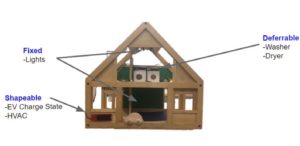
 Project team: Kan Ito, Sara Mitchell, Liam Weaver, Brandon Wong
Project team: Kan Ito, Sara Mitchell, Liam Weaver, Brandon Wong
Course: Design of Cyber Physical Systems, fall 2016
Residential energy consumption in the United States will likely increase as population and access to advanced technologies continue to rise. Ideally, this demand will be met by a higher percentage of renewable sources than that of the current energy mix. However, renewable energy generation doesn’t always line up with the time that it’s used, which can lead to renewable curtailment and use of expensive, high-emission peaker plants. In order to take advantage of the cleaner energy produced during the day, consumers’ load schedules can be optimized to minimize emissions through direct load control and interruptible control management of non-critical loads.
The Go Green, Go Home student team demonstrated this concept by developing an optimization problem that creates load schedules based on time constraints reported by the user and data about the emission intensity of electricity produced throughout the day. Using accessible tools like Arduino, the team simulated this system in a model home, actuating loads for a single day. Their preliminary results pointed to significant CO2 equivalent savings in households, and a more than 20% reduction in peak power demand. Scaling this solution to communities could revolutionize residential energy consumption: by integrating consumer energy demand, clean energy generation, and optimized control within a cyber-physical network, communities can transition away from high-emission fossil fuels and towards an efficient and sustainable electricity grid.
Want to learn more about this project and its designers? Check out: